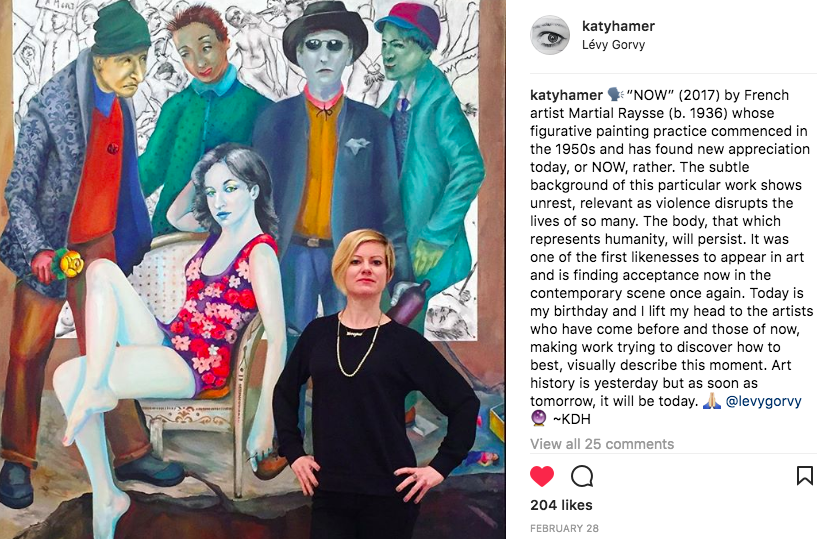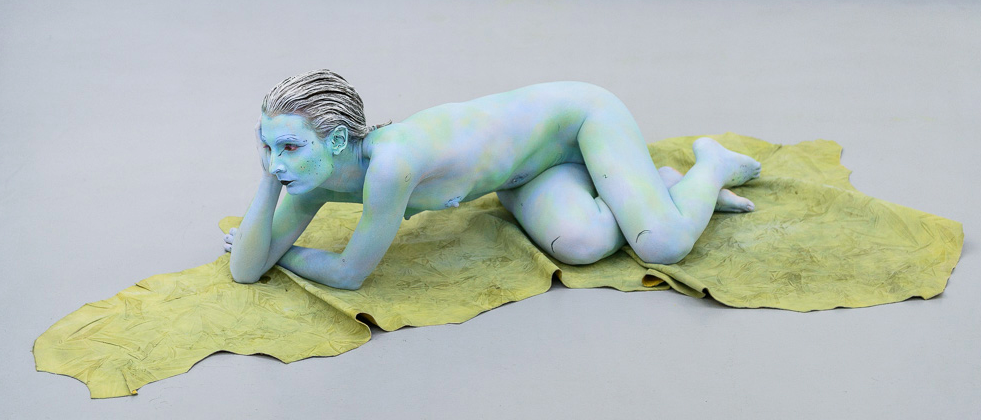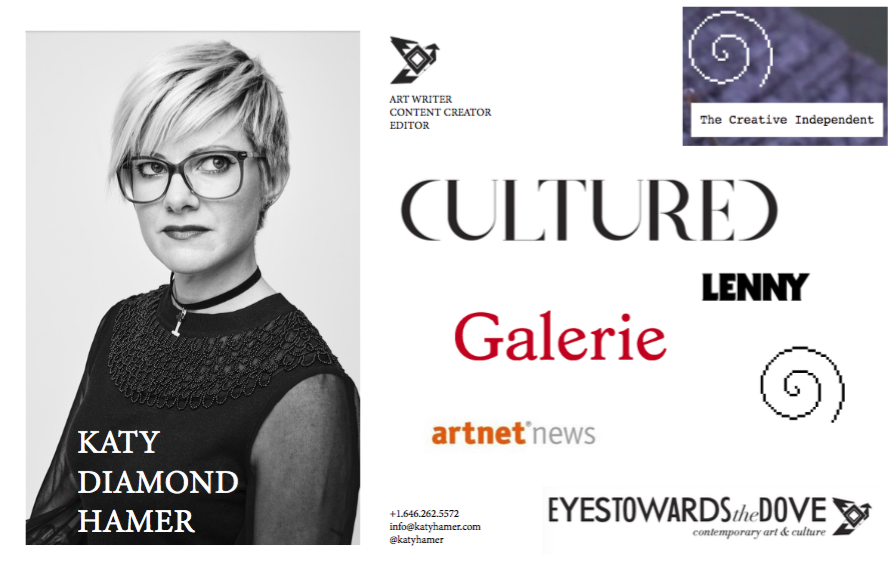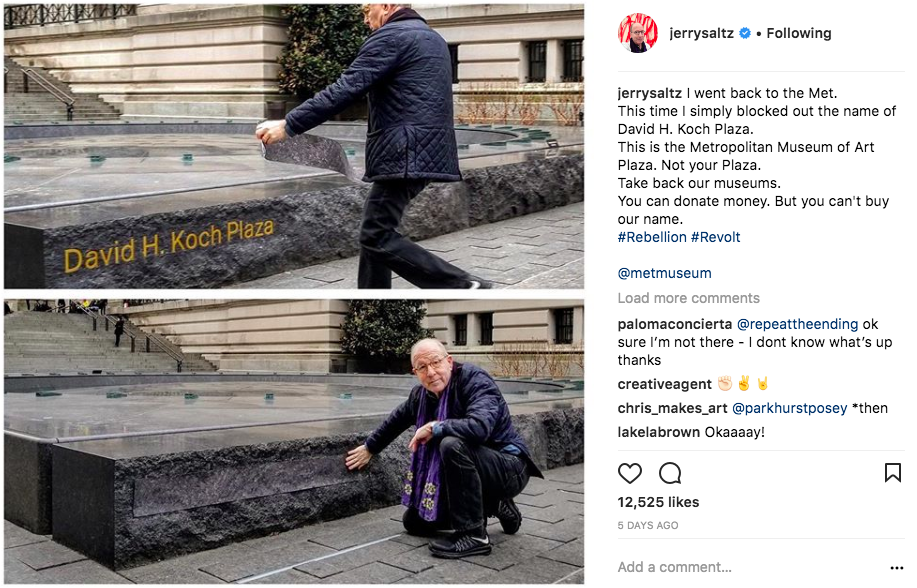Instagram.

@katyhamer Instagram screenshot from February 28th, 2018, For the press preview of “Martial Raysse at Levy Gorvey Gallery, New York
Started in 2007, Eyes Towards the Dove has been my foray into writing about art after being a novice poet scribbling in notebooks over the years and filling sketchbooks with musings. There is so much joy that I feel putting my thoughts about an artwork into the written language; dissecting forms and colors whether in two-dimensional or three-dimensional space via the written word. I’ve invested time and energy over the years into this labor of love with conviction, if not financial gain. However, something started to change once I joined Instagram; paragraphs were replaced by images and captions. Rather then invest 8 hours writing an article gathering photos and captions, I could now post a photograph or a carousel of photographs with a short caption and get a similar result, feedback from my peers and colleagues. At first this felt like reward enough but as time has gone by, I’ve grown distant from words, the delicious descriptions of art that I so often am drawn to and fueled by. The withdrawal has been painful. In the discomfort I’ve found mostly silence. Images in the realm of social media allow for dialogue and engagement but are at once enlightening and limiting. Passion is connected to love and love is connected to desire. What happens when the desire starts to falter and recognition that quality of life can be better emerges?
Words can pay the bills. This is a fact. It’s something I’ve learned over the last couple of years and have been so grateful to say that I’ve paid my rent with words that have been published in magazines, including Cultured, Galerie, Lenny Letter, The Creative Independent, SEEN/New York Magazine, Artnet, and others. Yet, I’ve also accrued debt and lost money, even on press trips. Eyes Towards the Dove has given me the freedom to post exactly what I want without being edited, without agenda -favor or advertising- other than my own. Even now, sitting in my tiny Brooklyn apartment, sun streaming in the window as snow melts outside, the written word and sounds of keys clicking on the keyboard assist in helping me feel alive. The last few months, I’ve sat, marginally touching the keyboard and scrolling through Instagram pictures, looking at the lives of others and contemporary art both near and far. I actively and happily participate in this digital feed by documenting visits to galleries, museums, events, and press conferences in order to share with others. The fact that there is an immediate response, is something we cannot take for granted. This is how social media works, it allows for instant connection through distance. In my lifetime, I’ve participated in Myspace, Friendster, Facebook, Instagram and very limited engagement on Twitter which has been my least personal favorite. I’ve made real friends and have acquaintances both near and far. I’ve gone on dates with men I’ve met on these platforms and looked for others who might be dating material. Most of all, I’ve looked at art, dripping and all-encompassing on my tiny iPhone screen.
The screen.
The art I’ve sought out on Instagram is probably not unlike the art I’ve posted myself or written about here. One of the biggest differences is that the act of looking requires less time and energy than writing an entire article. This conundrum is something that I need to remedy. It’s something I’ve thought about for months, while scrolling, liking and commenting. The reality is that I, like most of us, need to make money and I’ve yet to figure out how clicks can transpire to dollars and yet know that many out there making this happen. It’s led me to a fork in the road. On one side is my writing, the lush green brush of a forest and on the other side, shiny corporate buildings glistening in the sunshine, light fractals bouncing from one to the other. Both options are visually appealing. Undoubtedly, one feels more prosperous than the other. One has a fleshy exposed underbelly while the other is protected, a bit more secure and solid.
I’m at the precipice and have to admit that age and experience have everything to do with it. I admire the Millennial vigor and the zest they bring to journalism. I admire the influencers who show people their gorgeous lives documented in photographs giving others something to strive for, imitate or envy. I admire the writers who have started, finished and sold books. I admire the craft of writing and am blown away by the visibility I’ve been able to foster over the years. It’s the industry that I struggle with. Freelancing has its pluses but is also very difficult. It requires budgeting for months in advance as sometimes payment can take from 3 to 6 months and even a year. This is disheartening but also par for the course.
But.
What does art look like? Try to describe it without words, without language. We can show it and look at it, but without language as a method used to decipher the semiotics of the visual, what is there? Considering the contemporary and all that has come before using the vernacular as a way to communicate has been a delight for me. Optically, I could describe it as a multitude of crystals hanging from a ceiling. At various heights, the crystals catch and refract light from an open window, casting hundreds of prisms around the room, a lush carpet underfoot. This is how I feel about writing about art. It releases magic.
Magic.
Today, the goal is to keep going. To remember that words are just as strong as images on Instagram, if not stronger. Words matter.
Inspiration.
Who do I look towards for inspiration? I look towards Jerry Saltz, Roberta Smith, Linda Yablonsky and Holland Cotter. Their voices remain strong and steady and each one has persisted through curveballs of life, health issues, the economy, and the uncertainty of the art world. I truly believe that journalists and art writers play a tremendous role in the art market and are probably one of the most undervalued components. There are ways to make financial security more manageable including teaching, doing artist talks, working as a guest critic, writing catalogue essays, etc. It is a world of diamonds and cubic zirconia, glamour and shabby chic, smiles and smirks but those who persevere will find that the physical world shrinks. I can travel to many urban centers around the globe and find people I know or at least those who I’m familiar with through art fairs and exhibitions. While the world is big, the art world is relatively small and in my experience, faces are friendly, but I’m sure that could change based on what someone has to offer. The fact of the matter is that everyone wants good press, or at least considered press and the latter is much harder to come by. Now I may not be an expert, but I am a participant and a grateful one at that.

Salvador Dalí, “The Persistence of Memory” (1931) Oil on canvas, Part of the Permanent Collection of the Museum of Modern Art, New York
Life.
There are so many moments in my life that I can pinpoint to the art I happened to be looking at. This goes back to the first time I saw the “Persistence of Memory” by Salvador Dalí at the Museum of Modern Art at 16 years old. Then in 1999, a show called “Sensation” opened at the Brooklyn Museum causing a stir, with controversial works by Chris Offili and Damien Hirst. Visiting the Picasso Museum in Barcelona in 2000, I finally understood the choices artists have and how cultural and artistic movements are made. Also in 2000, a sculpture by Tony Ousler stood out to me at Barcelona Museum of Contemporary Art and I remember staring at the strangeness of the blinking eyes giving animated life to an inanimate objects. Larger than life, the paintings of Jenny Saville at the Saatchi Gallery in Swiss Cottage (its original location) blew me away as she seemed to know how bodies work from the inside out, moving flesh on the surface of the canvas in large, squishy strokes. Not long after, I lifted my head inquisitively to look at the Fibonacci number series as portrayed in neon by Mario Merz in “From Zero to Infinity: Arte Povera 1962-1972” at the Tate Modern (2001). Also, never forgetting the second time I saw sculptures by Arte Povera artist Jannis Kounellis at Luigi Pecci Center for Contemporary Art in Prato, 2003. His installation included large slabs of meat hung directly on the gallery walls, dripping with blood, a gallery attendant told me they needed to be changed every few days due to the smell. This is something that due to health concerns would never be shown in the US. It was years later when I was able to speak to Kounellis at Gallery Gavin Brown, the artist disclosing that this particular work was all about painting. My heart soared.
Art.
In 2007, Lyle Ashton Harris, an artist who I now call friend, was featured in the first ever African Pavilion in the Venice Biennale and I remember being part of tour with curator Simon Njami. Njami’s catalogue text, “The Shock of Being Seen” still resonates today and gave words to the conjuring of what it means to be brown body, assigning accountability to those who enforced slavery, the kind that continues today through other forms of injustice. At dOCUMENTA (13) in 2012, Tino Sehgal, Theaster Gates, Ryan Gander and Ceal Floyer all found ways to occupy space through bodies, air, sound and architectural intervention. Being present for their works and performances sent chills through my being. If reaching the sublime is the goal or Stendhal’s syndrome, art will continue and those who look will carry on. Who are the artists today who I feel have the aesthetic resonance to truly capture our time in a way that corresponds smartly with art history? The first who come to mind are artist’s I’ve been following for several years and all have a subtle relationships with space and leap into territory all their own. These include Donna Huanca, Michael E. Smith, Ryan Gander and Sondra Perry. Other contemporary favorites include Tala Madani, Gian Maria Tosatti, Ed Atkins and Korakrit Arunanondchai. Creating new dialogues around painting, sculpture and installation these artists are all quite different and yet similarly have something that many working today do not have, the power to incite feeling.

Donna Huanca, Installation detail from “Water Scars” at Valentin, Paris, 2015, Image courtesy of the artist
Feeling.
Ideally art should invoke something; the past, the present, love, loss, the presence of the body or the absence of the body. In the distant past, artists made work in order to feel closer to God or nature. This is not very different today, however contemporary artists strive to undo what has been done. Some do this better than others. I often respond to artists who know how to handle vacancy and make room for the frame of the viewer, even when invisible.
Invisible.
What does this all mean? In 2012, I paused my art making practice with the goal to be able to look at it more objectively. In the last three months I’ve felt this way about my writing and granted space accordingly analyzing where it can be leveraged for the type of success I desire. A few years ago, a therapist who was very dear to me said she’d like to see me thrive rather than just survive. Since 2011, as a freelance writer I’ve been offered $0, $50, $150, $250, $300, and $350 per article on the web and up to 97 cents a word for print, catalogue texts excluded. Rates aren’t often discussed between colleagues and I don’t know if this is average or not. For many years I did other projects to make writing work and the debt emerged once I just transferred to writing exclusively. With debt and a yearning for more challenges, I’ve come to realize that freelancing is no longer ideal. Who knows, there might be a book in my future, a staff position, or employment at a university or corporate institution. Fashion companies I love have been partnering with artists and bringing branded contemporary art content to a diverse and global audience. I’m not sure what the future holds, it will probably involve freelance to some extent, but my heart and mind are open and I know for a fact that…
More will be revealed.
_______________________________________________________________________________________________________________
Katy Diamond Hamer is the Founding Editor of Eyes Towards the Dove a platform on contemporary art and culture. She writes for several publications and has done public speaking on numerous occasions. For more of her writing and art life travels, follow her on Instagram @katyhamer



